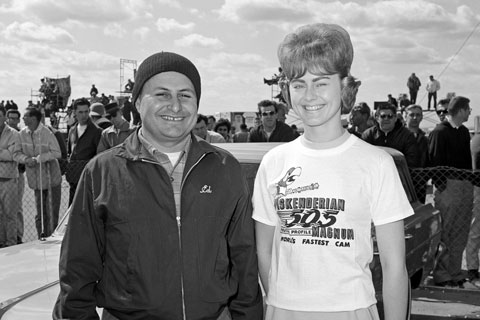SEMA News—October 2013
HERITAGE
By Drew Hardin
Photo Courtesy Petersen Archives
Bonneville Giants
 On October 2, 1964, Walt Arfons’ Wingfoot Express, with Tom Green at the wheel, earned a place in land-speed racing history by setting a new record of 413.20 mph, besting the previous 407.45 mark set the previous year by Craig Breedlove.
On October 2, 1964, Walt Arfons’ Wingfoot Express, with Tom Green at the wheel, earned a place in land-speed racing history by setting a new record of 413.20 mph, besting the previous 407.45 mark set the previous year by Craig Breedlove.
Turned out Walt’s record would be short-lived. His half-brother, Art Arfons, set a 434.02-mph mark just three days later in his Green Monster. Breedlove eclipsed that mark with a 526.28-mph average before famously running his Spirit of America into a water-filled ditch, only to have Art come back and top that, running the Monster to a 536.71-mph average.
Bonneville was a busy place in October of 1964.
Walt, who passed away in June at age 96, never experienced the same level of success as his brother, even though he is credited with pioneering the use of jet engines on dragsters. Walt’s first jet car, which used a Navy-surplus Westinghouse engine, was built in 1960. It carried another of Walt’s innovations: drogue parachutes to slow the car.
Walt’s first land-speed record attempt in the Wingfoot Express—its name a tribute to sponsor Goodyear Tire’s company logo—was at Bonneville in the summer of 1963.
“The trial runs proved unsatisfactory,” wrote Dick Wells in the January 1966 issue of Hot Rod magazine, as “the engine gulped through its intake a snoutful of salt.” Walt brought the Wingfoot Express back to Bonneville in September 1964 (when Hot Rod photographer Eric Rickman snapped this photo for the January 1965 issue) and had to sort out some power-delivery issues before making the record runs in early October.
Wells’ 1966 Hot Rod story was a roundup of the various teams making jet-powered and wheel-driven assaults on speed records at Bonneville in 1965. Walt returned that year with an all-new Wingfoot—this one a needle-nosed, dart-shaped racer. He again proved to be an innovator, exchanging the previous year’s jet propulsion system for a series of jet-assisted takeoff (JATO) rockets.
The rocket-powered Wingfoot showed early promise, with shakedown runs clocked at over 400 mph. But technical gremlins kept the car from ever fully delivering on its potential, even after 10 additional JATO rockets were mounted to augment the original 15.
During what was to be the Wingfoot Express’s final run in 1965, driver Bob Tatroe was traveling at more than 400 mph when the car’s retro-rocket system—which was supposed to brake the car in an emergency—went off unintentionally.
“The retros accidentally went into action, forcing a reverse thrust and causing a fire,” Wells wrote. “As Tatroe and the Express streaked across the salt, behind was a trail of flames from the burning tail of the car, along with the rockets blazing their power.
It was a spectacular show, but a frustrating climax to Walt Arfons’ attempt at the land-speed racing record.”






